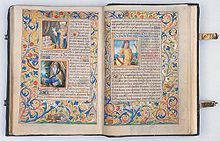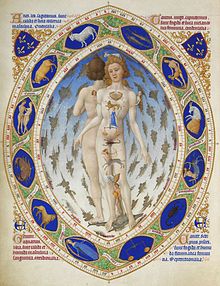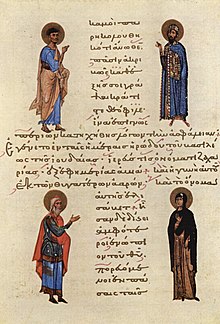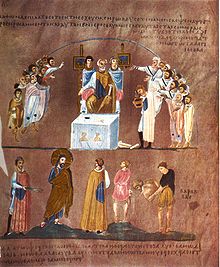Book illumination

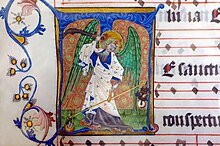
The Illumination is an art form that deals with the scenic design of books dealing and other written works. The term book illumination includes, in a narrower sense, all paintings in a book, but is also used for graphic illustrations . The entirety of picturesque book decorations , especially when the paintings are supplemented by gilding , is also called illumination .
The book illustration of antiquity appeared between the 2nd and 4th centuries AD with the invention of the bound codex , but could be traced back to the 2nd millennium BC. Chr. Standing tradition of painted scrolls draw. After the fall of the Roman Empire , Byzantine book illumination carried on the ancient legacy with changes in style, but essentially continued in an unbroken tradition until the end of the Byzantine Empire in the 15th century. The influence field of Byzantine art included in the Middle Ages , large parts of Asia Minor , the Balkans , Russia and, to a lesser extent, the Coptic art .
In the West , in other words, in western Latin Europe, book illumination was characterized by a constant change in style. In the early Middle Ages , first the Merovingian and the island illumination of Ireland and England appeared. In Carolingian art , book illumination was under strong Byzantine influence and then went over to Ottonian book illumination . The Romanesque was the first epoch that united regional schools of painting into a European style through unifying characteristics. The Gothic began in France and England around 1160/1170, while in Germany Romanesque forms remained dominant until around 1300. Throughout the entire Gothic epoch, France, as the leading art nation, was decisive for the stylistic developments in book illumination. During the Renaissance , book illumination lost its importance due to the prevalence of book printing and printing processes . Until then, it was on an equal footing with panel and wall painting . Modern, painterly designed books are usually not included in book illumination.
The Islamic Arts began in the 11th century and was governed by two opposing basic positions: on the one hand, Islam is a religion of the book, on the other hand, a prohibited Bilderverbot figural representations, though the Koran does not formulate the ban directly. Religious works are therefore limited to magnificent ornamentation and calligraphy . Although the prohibition is not limited to the religious sphere according to a strictly orthodox view, extremely imaginative figural painting can be found in the secular area. Starting from Arabia , Islamic book art spread to Persia , India , the Ottoman Empire and Spain .
In pre-Columbian America had its own book painting tradition that for a while lived after the conquest of South and Central America by the Spaniards under the sign of the Christian colonization. Today only a few Aztec and Maya codices have survived.
Occidental illumination
Forms and functions
Illumination is a research subject in art history . Codicology deals with all material aspects of the book , questions about the conditions of the artist concern the historical sociology of art . The reception and processing of book illumination by an audience that also includes subsequent artists is referred to as reception . The questions about the original creation situations or functions of a medieval work of art are often summarized as those about its " seat in life ".
In the medieval art system, the book occupied an important position due to two properties that distinguish it primarily from frescoes and mosaics , but also from panel paintings : on the one hand, through the combination of image and text, on the other hand, through its mobility, wide distribution and direct copies made possible by the original.
Materials and Techniques
The Codex of parchment sparked between the 2nd and the 4th century AD, the papyrus scroll and marks the beginning of the actual illumination. For miniature painting , the book primarily meant that with the individual pages, a closed area provided the framework for the illustrations. The ability to page forwards and backwards favored a text-structuring function of book illumination. Until then, the principle of adding images to the ongoing text column had been retained . Due to the flat, no longer rolled up painting ground, thicker layers of paint could also be applied to the parchment, so that the representative opaque paint also established itself with the book . The format of the folded sheets had a natural upper limit due to the dimensions of the animal hides used. The largest known parchment manuscript is the Codex Gigas described in Bohemia around 1229 , which weighs 75 kg at 92 cm high, 50 cm wide and 22 cm thick.
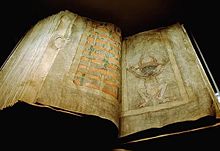
It was painted with thin brushes and watercolors or opaque colors, drawn with Indian ink and a goose quill . As a red colorant found Red ocher , vermilion , red lead , Carmine , Vermiculum , Folium , dragon's blood , madder and later brazilwood use. The precious purple was used in antiquity and in the early Middle Ages to color some particularly magnificent parchment manuscripts, which were then written on with gold or silver ink. For yellow colors were yellow ocher, orpiment , lead yellow , saffron and Wau available for green shades green earth , malachite and verdigris and ultramarine , azurite and indigo as a blue colorant. For white and blacks were lead and bone white or carbon black used. In the Middle Ages isinglass , egg white or rubber were used as binders . In magnificent manuscripts, the colored background of an image can be replaced by a gold background . In the late Middle Ages, the glazed pen and ink drawing prevailed for manuscripts that required less equipment , while opaque color painting was reserved for representative codices.

The rapid spread of letterpress printing and prints, initially mostly hand-colored afterwards, in the second half of the 15th century meant the decline of book illumination. By 1450 the woodcut , especially in the form of the block book , was in competition with the lavish illumination. By the end of the 15th century, copperplate engraving had surpassed book illumination not only in terms of efficiency, but also in artistic terms: great Renaissance artists such as Master ES , Martin Schongauer , Albrecht Dürer or Hans Burgkmair the Elder devoted theirs to graphic techniques and not to book illumination greatest attention. With the printing process, the book had changed from an individual work of art to a mass medium .
In addition to book printing, the introduction of paper as a writing material fundamentally revolutionized the book industry. The paper was invented in China as early as the 8th century, established itself in Arabia in the 12th century and reached Europe in the 13th and 14th centuries. In the 15th century it almost completely displaced parchment and made the production of books much cheaper. The spread of book printing and paper combined brought about enormous increases in book production and ensured that the book became affordable for the urban bourgeoisie as a new class of buyers.
The structure of the text page and decorative elements

The entirety of the decorative elements used in a book is referred to as illumination, which is usually based on a planning concept, the program of the handwriting. In addition to the text-related illustrations, the illumination includes all of the text markups and the design of the margins.
The miniature was either integrated into the text, which was often written in two columns , in a space left out for this purpose , or it took up an entire sheet, the picture page. Miniatures that take up the entire width and a maximum of half the height of the text area are called striped images. Several horizontal image strips (registers) on top of one another can form a register image.
The initial , the letter highlighted by ornaments at the beginning of a text or section of text, arose from the practice of enlarging the first letter on each page since the 4th century. In the second half of the 4th century, initials filled with geometric and from the 6th century with zoomorphic elements appear for the first time . This now increasingly fulfilled the function of structuring the text. The simpler capitals or capitals are to be distinguished from the initials , structured capital letters, which, like the chapter headings, are set off in red from the text usually written in black . In the Gothic, blue markup fonts were added.
The free surfaces at the edges of a sheet - gutter inside, top web above, foreign or cut web and foot or tail bridge below - are usually in a ratio of about 3: 5: 5: 8, the lower edge so let the largest space for Marginal illustrations. Often the division of the page was based on the golden ratio. The tendrils of the initials could protrude far into the blank edges of the sheet and in Gothic times form borders that filled the entire sheet. Figurative representations outside the font column are referred to as marginal illustration if they are related to text, otherwise they are autonomous marginal drawings. Framed pictures in opaque color painting the size of a complete column are marginal miniatures.
Text types of illustrated manuscripts

The basis of religious literature in the area of the Roman Church was the Bible , which was mostly written in Latin , the exact composition of which was by no means undisputed. For example, the Apocalypse was rejected as part of the Holy Scriptures until the 9th century, but after canonization the text was a preferred subject of book illustration. Other books often illustrated were Genesis , the Gospels, and the Psalter , which were often combined with theological commentary. Those books that were temporarily assigned to the Bible but ultimately not canonized are called Apocrypha and have often had a strong influence on the iconography of biblical subjects. The furnishing of the various biblical books with illustrations is very uneven, which is due to the fact that the late antique and early medieval picture cycles had the function of supporting typological exegesis , i.e. the discovery of the multiple sense of writing in the sense of late antique symbol theory. The books of the Bible were initially mostly written down individually, only a few large-format and often splendidly furnished full Bibles were used for reading in the monasteries. It was not until the high Middle Ages that the one-volume full Bible in octave format appeared for private use, especially in the vicinity of the Paris University . It was produced in the 13th century as a handy pocket Bible in such large numbers that it was largely in demand until the advent of printing was covered. Special interpretive types of Bible illustration were the Bibles moralisées created at the French court around 1220/1230 , the Biblia pauperum , which was widespread in southern Germany in the first half of the 13th century, or the history Bible of the late Middle Ages .
The Gospels were the starting point for the liturgical books and - especially in the early Middle Ages and Romanesque periods - were illustrated as a splendid manuscript. The most important liturgical texts are the Psalter, the Antiphonary , the Graduale Romanum , the Lectionary , the Pericope Book , the Processional , the Plenary , the Ritual , the Sacramentary and the Missal , all of which were preferably illuminated according to their religious significance. The most important features of these books were the decorative initials and the image of the Evangelist , as well as the motif of the Maiestas Domini or a life of Jesus cycle . In scholastic times, the level of equipment in liturgical books decreased as the number of codices produced exploded.
Theological treatises and sermons were illustrated less often than study texts, and legendaries were more often illustrated. The first illustrated lives of saints and biographies of church officials can already be found in Carolingian times. In the late Middle Ages, the private prayer , devotion and edification book for laypeople emerged , which - especially in the form of the book of hours - became the most common and most splendid illuminated type of book.
Among the non-theological sciences, mainly works of natural science were illustrated. The Physiologus has been one of the richly decorated standard works since ancient times . Animal books often overlapped with travelogues and mixed nature observation with the representation of mythical creatures in bestiaries . In addition, astronomical and astrological works with images of the month and signs of the zodiac were consistently popular objects in book illumination, and to a lesser extent alchemical texts. Illustrated medical treatises and herbaria were also widespread from antiquity to the end of book illumination . An illustrated encyclopedia is De rerum naturis by Hrabanus Maurus . In the Middle Ages, the iconography of all these types was determined by the position of the authorities; after antiquity, empirical observation of nature only came into focus again in the late Gothic period. An outstanding example is the Falkenbuch (De arte venandi cum avibus) of the Staufer Emperor Frederick II , which not only offers a large number of ornithologically identifiable bird species in realistic reproduction, but also precise technical drawings for falconry. In addition to the theory of nature, the law represented the second area of richly decorated specialist literature. Mostly it was imperial or papal bulls , which were produced as splendid editions, but also collections of popular law such as the Sachsenspiegel in the 13th century were illustrated with more modest means.
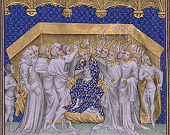
On the whole, secular materials were decorated much less often and with comparatively little artistic and material demands than religious themes. One genre stands out due to its level of furnishing: only in the chronicle could the pictures be provided with a gold ground under certain circumstances, as in liturgical texts. Most of the world , city, monastery or family chronicles , however, are much more modest, even if they are often rich in pictures. The first illustrated historical work on contemporary history is the richly illustrated Liber ad honorem Augusti by Petrus de Ebulo about the conquest of southern Italy and Sicily by the Hohenstaufen emperor Henry VI. Between historiography and fictional literature stood the chanson de geste about the deeds of Charlemagne , so that this subject area was illustrated more ambitiously with opaque color painting than other literary genres. It is noticeable that in the German-speaking countries texts of the heroic epic were almost completely non-illustrated. The illuminated manuscripts with works from the Arthurian epic and individual song books , among which the Codex Manesse stands out, are more splendid . In the late Middle Ages the number of illustrations of courtly poetry increased, but only to the extent that book production increased overall. The colored pen drawing prevailed for the epic or the novel . In the late Middle Ages, free poetic creations emerged, such as the rose novel by Guillaume de Lorris or Dante's Divina Commedia , the illustrations of which were also highlights of book illumination. It should be noted that medieval book illustration was only gradually able to free itself from its dependence on the iconographic tradition of the late antique picture cycles. Correspondingly late and hesitant, the illustration of his own literary production, i.e. post-antique works, for which the corresponding templates were naturally missing. The predominance of illustrated poetic literature is striking.
Artist, client and audience
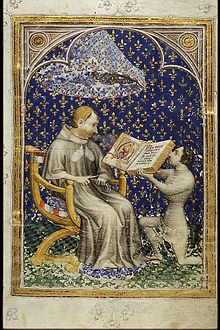
The monopoly of book production lay with the monasteries until the Romanesque era. Even in Carolingian and Ottonian times, important painter monks seem to have been mobile and not necessarily tied to a scriptorium. While the scribes often mentioned themselves in colophons , the great majority of the illuminators remained anonymous and can usually only be identified indirectly. Nevertheless, names of artists have been passed down since ancient times. Well-known painters have increasingly been palpable since the 13th century, in large numbers in the late Gothic and Renaissance periods. In the 15th century, famous artists who also emerged as panel painters , such as Jan van Eyck , Jean Fouquet , Jean Colombe , Stefan Lochner or Mantegna, were the heads of large, efficient workshops.
Around 1200, secular, commercial writing rooms emerged, especially around the early universities in Paris and Bologna , and artist studios followed a little later. The creation of a codex was based on a division of labor; scribe and painter were only rarely identical. The scribe usually put instructions in fine writing on the fields to be designed by the painter, which were then painted over. When designing the works, the illuminators often followed the templates or used sample books . In the course of time, the division of labor steadily increased, until in the Gothic period, individual apprentices or journeymen in large studios were only responsible for the background or certain pictorial objects, while the master designed the figures.

The parchment codex was an extremely valuable item that only very wealthy clients could afford. Even the raw material was expensive - with two double sheets per animal skin, 75 calves were required for a large folio manuscript with 300 sheets. The skins had to be laboriously processed. The writing and, if necessary, illustration work, which often lasted for years, was extremely laborious and labor-intensive. They did the rest to make handwriting a luxury item. The colors, often made from rare, sometimes imported minerals, were also expensive. Gold leaf decorations could only afford princes, bishops and wealthy monasteries on a larger scale. In Byzantium, the emperors reserved codices colored purple, which were inscribed with gold or silver inks, which were also used in the West .
If kings and princes were the most important clients of the Carolingian and Ottonian splendid codices, the most important Romanesque book illuminations were created, with a few exceptions, such as the Gospel Book of Henry the Lion , for the high clergy and for monastic communities. Not least because of the establishment of the Reform Order , there was an increased exchange of artists and manuscripts in the 12th century, as well as a rapidly growing need for liturgical books. For centuries, books have been produced for personal use or as a representative gift. Manuscripts that circulated as exchange or loan items served as templates. In the 13th century, dealers of used codices appeared, especially in the university environment. It was not until the 15th century that independent workshops prevailed, which manufactured manuscripts in stock without a specific order and then advertised their publishing program. The best-known writer and illustrator of this kind is Diebold Lauber , who can be traced back to Hagenau between 1427 and 1467 .
Style history
All epochs in art history are problematic and controversial. The Ottonian - and even the preceding Carolingian - art , which was spatially limited to the Roman Empire and defined by dynasties, is sometimes assigned to Romanesque . In addition, art historical developments always prevail with sometimes considerable regional delays. The Gothic began in France as early as the 12th century, while in Germany the Romanesque design language was retained until around 1250 - again with considerable temporal differences in the various artistic landscapes. The attribution of an illuminated manuscript to a specific scriptorium or the exact date are often controversial. The scientific debates can only be summarized here.
Late antiquity

The oldest surviving illustrations is rich imagings Egyptian Book of the Dead rolls of papyrus that after the development of hieratic writing to divide the text into columns served. Such dead scrolls from the New Kingdom (around 1550–1080 BC) are particularly numerous . Probably there were already artists in ancient Greece who specialized in painting scrolls. Painted scrolls, however, do not count as book illumination in the narrower sense - this only began between the 2nd and 4th centuries AD with the replacement of the not particularly tear-resistant papyrus by the more stable parchment .

The late antique illumination is extremely incomplete and can hardly be reliably reconstructed. Important examples of antique book illustrations have been handed down in fragments in manuscript waste from the Middle Ages, such as the oldest known Bible illustrations used as covers for Quedlinburg archives . Some idea of the lost wealth of late antique illustrated manuscripts also give very accurate early medieval copies, two Carolingian Aratus -Handschriften, an astronomical and astrological text or Terenzhandschrift .
An important topic in late Roman book illumination was the image of the ruler . Epic illustrations have survived several times from the 4th and 5th centuries, such as Virgil manuscripts . A calendar by Philocalus from the year 354, copies of which have been preserved in the 16th and 17th centuries, is the oldest example of full-page text illustrations. In Roman book illumination, the picture was increasingly separated from the text by painted decorative frames, but its task of illustrating texts remained. In terms of style, book illumination was strongly based on wall painting . The colors were applied flat without mixing them with one another. The miniators generally used templates, which resulted in standardized forms.

Ancient illumination reached a high point in the 7th century with Old Testament Bible illustrations created in North Africa or Spain, before - at least in the area of the Western Roman Empire - it went under or into early medieval art at the end of antiquity . The ancient heritage was most likely preserved in Northern Italian monastery scripts.
In the Eastern Roman Empire , on the other hand, book illumination lived on in (early) Byzantine art . In the 6th century the richly illustrated, only fragmentarily preserved Cotton Genesis was probably created at the famous Alexandria library . An Iliad manuscript, the Ilias Ambrosiana , the Vienna Dioscurides at the beginning of the 6th century , the Vienna Genesis and two purple codices , the Codex Rossano and the Fragmentum Sinopense, were probably created in Constantinople .
Insular book illumination
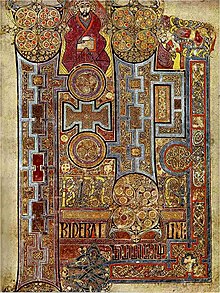
While ancient book illumination survived on a modest level in the center of the declining Western Roman Empire and passed into Merovingian art, it developed in the first half of the 7th century on the outermost periphery of Europe, far from the turmoil of the Migration Period and outside the earlier Roman civilization unmistakable, independent illustration style. In Ireland, where a distinct monastic culture had developed since Christianization in the 6th century , and in Northumbria evangelized from Ireland, a style developed in the 7th and 8th centuries that is summarized under the term insular illumination . Especially in the design of the initials, this combined the Germanic animal style and the ornamentation of the local Celtic handicrafts , such as the knot pattern , with the semi-uncial and the braided band of antiquity. The highly complex, often intertwined and the entire page filling ornaments took over the calligraphically also masterful script to the point of illegibility and also dominated the relatively rare figurative representations, which are mostly evangelists. These almost always fix the viewer frontally and strictly symmetrically, their robes are highly abstract braids. Almost all insular manuscripts are evangelists . Due to the perfection of the ornamentation, which is freely drawn in contrast to Merovingian art, the magnificent insular manuscripts that have been preserved are among the highlights of book illumination of all times. Another school in the double monastery Wearmouth-Jarrow, on the other hand, handed down late antique models true to the original. In the south of England, Canterbury was the center of the Roman mission. The small-format so-called "pocket evangelists" made for wandering missionaries, which were probably manufactured in large numbers, were less demanding. The European continent has been particularly true of Ireland and southern England missionary . All over France, Germany and even Italy, monasteries with Irish monks, the so-called Schottenklöster, sprang up in the 6th and 7th centuries . These included Annegray , Luxeuil , St. Gallen , Fulda , Würzburg , Regensburg , Echternach and Bobbio . Numerous illuminated manuscripts reached the mainland via this route and had a strong influence on the respective regional formal languages, especially in terms of writing and ornamentation. While book production in Ireland largely came to a standstill due to the attacks of the Vikings around 800, illuminated manuscripts in Irish tradition continued to emerge on the mainland for a few decades. In the Ottonian times, the insular book illumination was to be used again as a source of inspiration.
Merovingian book illumination
The continental, Franconian art of illustration in the second half of the 7th and 8th centuries is known as Merovingian book illumination . Ornamentally designed initials linked to antiquity, constructed with rulers and compasses, and cover pictures with arcades and set cross are almost the only form of illustration, figurative representations are almost completely absent. Since the 8th century, zoomorphic ornaments have increasingly appeared, which have become so dominant that, for example, in manuscripts from the Chelles women's monastery, entire lines consist exclusively of letters made from animals. In contrast to the simultaneous insular illumination with its rampant ornamentation, the Merovingian strove for a clear order of the sheet.
One of the oldest and most productive scriptoria was that of the Luxeuil monastery founded in 590 by the Irish monk Columban , which was destroyed in 732. The Corbie Monastery, founded in 662, developed its own distinctive style of illustration, Chelles and Laon were further centers of Merovingian book illustration. From the middle of the 8th century, this was strongly influenced by the island illumination. Echternach Monastery , founded by Willibrord , had a strong influence on continental book illumination and carried Irish culture into the Merovingian Empire.
Carolingian book illumination
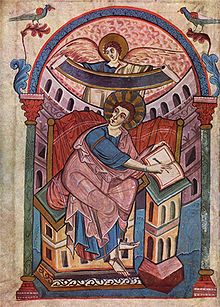
The line between the Merovingian and Carolingian art , named after Frankish dynasties, is fluid. The imperial need for representation as well as the religious aura have already been made clear by the exclusive execution of many Carolingian manuscripts in gold ink on purple- colored parchment. While monasteries were solely responsible for book production during the Merovingian era , the Carolingian renaissance was largely based on the Aachen court of Charlemagne , where magnificent manuscripts were created since around 780. What the manuscripts of the so-called “Court School of Charlemagne” or “ Ada Group ” have in common is the deliberate examination of the ancient heritage, a consistent image program and uniform formats. In addition to magnificent arcades, framed canon tables and initials influenced by the island, large-scale evangelist pictures with clearly contoured interior drawings are part of the equipment, to which corporeality and three-dimensionality have been restored for the first time since late antiquity. Part of the pictorial program were the precious book covers , some of which have been preserved with ivory carvings .
A second group of manuscripts, probably also created in Aachen around 800, but clearly deviating from the illustrations of the court school, is more in the Hellenistic tradition and was probably created by Italobyzantine artists. This painting school is called the “palace school” or “group of the Viennese coronation evangelist ”. In comparison with the so-called Ada group , they lack the horror vacui , the fear of emptiness.
Under Ludwig the Pious and Charles the Bald , court art shifted to Reims , where the dynamically moving image conception of the Viennese coronation gospel was particularly well received. Here, under Archbishop Ebo, extraordinary manuscripts were created, all of which are characterized by an expressive liveliness. In addition to the imperial court, the large imperial monasteries and bishops' residences with powerful scriptoria gradually appeared. Among the monasteries, St. Martin in Tours held a leading role until it was destroyed by the Normans in the second half of the 9th century . The Metz school followed up on the manuscripts of Karl's court school. In the north and east of the West Franconian Empire , the so-called Franco-Saxon (i.e. Anglo-Saxon) school developed from the second half of the 9th century, whose book decoration was largely limited to ornamentation and again resorted to insular illumination.
Ottonian and pre-Romanesque book illumination

The Ottoman Illumination began with the transition of the East Frankish kingship 919 to the Saxon family of the Ottos one that from 962 the Emperor of the Holy Roman Empire presented. Thus the cultural focus of the empire shifted more strongly to the Saxon area. With the eastward expansion of the empire and the foundation of the diocese of Magdeburg , the need for magnificent liturgical books grew, especially in the northeast. Stylistically, the era extends well beyond the reign of the last Ottonian emperor, Henry II, until the end of the 11th century. Since an epoch designation after a ruling dynasty means not only a temporal but also a spatial limitation, art studies outside the empire speak of pre-Romanesque or early Romanesque art. In addition to the emperors, the high clergy in particular commissioned magnificent manuscripts, whose position was strengthened by the imperial church system .
The early Ottonian manuscripts are still clearly in the Carolingian tradition. Like these, the magnificent Ottonian manuscripts are based on a programmatic reference to the ancient tradition, so that this epoch is referred to as the Ottonian Renaissance based on the Carolingian Renaissance . Nonetheless, ancient naturalism and illusionism, which had been adapted in some manuscripts in Carolingian times, were now completely sacrificed to a stylized formal language. The most important links between Carolingian and Ottonian book illumination were St. Gallen, the Fulda Abbey and the Corvey Abbey on the Weser , which was founded in 815/822 as a Carolingian foundation on Saxon territory and continued the Franco-Saxon school. A court school like in Carolingian times no longer seems to have existed. The most important art centers at the time of Otto I were Cologne , where an unmistakable painterly style with Byzantine influence developed. It is characterized by soft, flowing seam lines, the absence of symbols in evangelist pictures and the fact that each or at least almost each picture side is facing a text page. Important workshops in Cologne were St. Pantaleon , the workshop of Johannes von Valkenburg and the Poor Clare Monastery. In addition, the places of origin are of great importance: Trier , Regensburg , especially the Reichenau monastery , as well as the scriptoria in Mainz , Prüm , Echternach and elsewhere. In the 11th century Tegernsee , Niederalteich , Freising and Salzburg were added in the Bavarian-Austrian region .

An important pioneer of Ottonian book illumination was an anonymous artist who, partly on behalf of King Otto II , worked in Lorsch , Reichenau, Fulda and Trier. A school of painting developed in Fulda, which preserved the Carolingian style of the Ada group particularly strongly. At the end of the 10th century, Hildesheim, flourishing under Bishop Bernward, emerged as an art center. Another center of book art was Cologne . Between 990 and 1020 Ottonian book illumination reached its peak with the works of the Liuthar group, which were probably created on the Reichenau. In 2004, the Reichenau manuscripts were included in the UNESCO list of world heritage documents .

During the entire Ottonian period, the image of the evangelist was a central motif, alongside the image of the ruler - often in the form of a dedication image - and the majestas domini , which serve to portray the client . Dominant style elements are symmetrical, flat representations with a monumental character. Many of the Ottonian illustrations are full-page, sometimes divided into two fields. Large, overly long and expressive figures with ecstatic, suggestive sign language and the courage to use empty, single-colored surfaces - mostly gold backgrounds - characterize the characteristic style of these manuscripts, which strongly influenced Expressionism in the 20th century . Spatial depth is completely lacking in the illustrations, overall the formal apparatus of Ottonian painting is greatly reduced. The early Salic period is still in the continuity of the Ottonian epoch. Under Emperor Heinrich III. the Echternach painting school rose to become the leading scriptorium.
In western France , where there were no clients comparable to the Ottonians in the 10th century, book illumination suffered greatly from the decline of the royal power and the Carolingian Church. The French art landscape showed strong regional differences. Centers were in the southwest Limoges and in the Loire region Fleury . In the north, the monastery script of St. Bertin under Abbot Odbert (986-1007), who brought the English painter to his workshop, dominated the illumination there. A little later, the monasteries of Saint-Denis and Saint-Germain-des-Prés near Paris , Saint-Vaast near Arras , Saint-Amand and Saint-Germain-des-Prés also emerge with richly illuminated manuscripts.

In England the singular Utrecht Psalter from Aachen, which was in Canterbury between the end of the 10th century and 1200 , promoted the reception of the Carolingian art of the Metz school. An idiosyncratic illusionistic style of drawing developed in Winchester Abbey since the 10th century, which remained dominant in England for a long time. The main works of this school are the Benedictionale by Æthelwold, written around 980, and the pontifical by Archbishop Robert, with its small folds of garments and strong emphasis on movements. In the decades that followed, the English style of drawing increased in stylization, with excessively long figures and even greater movement, until it approached the Romanesque figure style after the middle of the century.
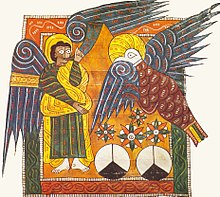
Largely isolated from the stylistic developments in the rest of Europe, but in direct confrontation with Islamic culture, which had gained a foothold on the Iberian Peninsula since the 8th century , a very unique, Mozarabic style with a very schematic design language developed in Christian Spain . The illustrated manuscripts from the Christian regions of León , Castile and Asturias are characterized by intense, large-scale colors and the complete negation of space . The most important book in Spain was a commentary on the apocalypses by the Asturian monk Beatus von Liébana from 776, of which 32 mostly illustrated copies have survived, especially from the 10th and 11th centuries . The Bible was also the most frequently illuminated book. The Catalan Illumination was more strongly influenced by France and was characterized by a different design.
Milan was a center of Italian illumination . In the second half of the 11th century, the so-called Giant Bibles were produced in Rome and Umbria , which were based on Carolingian book illumination and were intended to determine the Romanesque book illumination in central Italy.
Romanesque
Starting around the late 11th century, based on the architecture, the European art styles, which were also regionally different, were summarized as Romanesque . On the one hand, the number of manuscripts produced increased considerably; at the same time, the differences in landscape blurred in favor of a relatively uniform vocabulary of forms, even if this was designed to a large extent by the artist's individual personality. The characteristic type of book of the Romanesque was the large illustrated Bible. Especially north of the Alps, it was predominantly decorated with historicized initials, i.e. with figurative initials, which were populated with mythical creatures , chimeras , zoomorphic figures or even everyday scenes that had no place in representative art , regardless of the illustrated text . Characteristic stylistic elements of the Romanesque are fixed outlines, a clear weight distribution of the figures and ornamental symmetry. Most of the Romanesque miniatures - with the exception of the typical ornamental letters - are probably based on the monumental wall painting . These relationships of dependency can hardly be traced today, as only very few Romanesque frescoes have survived.

The most important clients were bishops, abbots and other high clerics, while kings and princes were hardly active as donors in the Romanesque epoch. As an exception, Henry the Lion must be mentioned here . The rapid increase in book production can be traced back to the numerous foundations of monasteries by the reform orders in the 11th and especially in the 12th century. Cistercian book illumination became particularly influential until the anti-image attitude of Bernhard von Clairvaux largely suppressed illustrations and historicized initials in the second half of the 12th century. Important impulses for illumination came from the reformed monasteries of Cluny and Cîteaux . The tight organization between mother and daughter monasteries was beneficial for the exchange of books .
The Italian centers of illumination were Rome and Monte Cassino , where the reception of Byzantine stylistic elements was to exert a decisive influence on the Romanesque illumination of the West. Abbot Desiderius, later Pope Viktor III. brought Byzantine painters to the scriptorium of the monastery of Monte Cassino, who developed a style here that was soon to spread across Europe. Around 1100 a Byzantine influence could be felt throughout the West, mediated by Italian artists working there in Cologne, for example. The northern Italian scriptoria were closer to the central European: Ivrea , Vercelli , Milan , Piacenza , Modena , Polirone and Bobbio .
While French book illumination had lost its charisma since the Carolingian period, it gained a hegemonic position in Europe in the Romanesque period, which essentially came from the monasteries of Cluny and Cîteaux. While the style development of the scriptorium can be traced for Cîteaux, this is not possible for Cluny, since the monastery library was destroyed during the French Revolution . In the south, the monasteries, which had been productive since Carolingian times, remained dominant: besides Limoges, especially Albi and Saint-Gilles . The focus of French art moved more and more to the Île de France , to Chartres , Laon and Paris , where the University of Paris was a determining factor in book production.
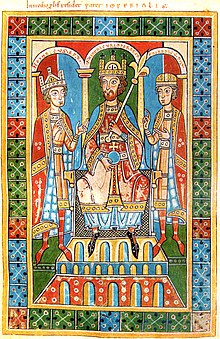
The Maasland with the Liège Cathedral St. Lambertus and various monasteries in the surrounding area was a particularly influential center of Romanesque book illumination, which also strongly influenced the painting schools of the Rhineland : Cologne , Siegburg , Prüm , Mainz , Maria Laach , Trier and Arnstein . The Rhenish-Thuringian school was also under strong Byzantine influence, as was that of Salzburg, which primarily influenced Sankt Florian , Admont and Mondsee . In southern Germany, especially in Swabia , book illumination flourished in the Cluniac reform monastery Hirsau , in the Guelph house monastery Weingarten , the Alsatian women's monastery Odilienberg and in the monasteries of Murbach , Zwiefalten , Regensburg , Würzburg and Bamberg . The Saxon-Westphalian illumination was coined in Corvey , Hildesheim , Halberstadt , Helmarshausen and Goslar .
The zigzag style , named after the angularly broken folds, leads in Germany from the Romanesque to the Gothic, which prevailed here in different regions between around 1260 and 1300.
In England the style of drawing continued to dominate, which had shaped Anglo-Saxon book illumination under the influence of the Utrecht Psalter in pre-Romanesque. Winchester and Canterbury remained the defining scriptories to which St. Albans , Rochester , Malmesbury , Hereford , Sherborne , Winchcombe and London joined. In the second half of the 12th century, however, a sophisticated opaque color painting developed here as well. The penetration of Romanesque style elements was favored by the connections to France since the conquest of England by the Normans in 1066.
Gothic

In France and England the Gothic began in book illumination around 1160/70, while in Germany Romanesque forms remained dominant until around 1300. Throughout the entire Gothic epoch, France, as the leading art nation, was decisive for the stylistic developments in book illumination. At the same time as the transition from the late Gothic to the Renaissance, book illumination lost its role as one of the most important art genres as a result of the spread of book printing in the second half of the 15th century.
At the turn of the 12th to the 13th century, commercial book production took on the side of monastic book production. The universities were the starting point for this serious turning point , but the high nobility was more important for illuminating, and was added a little later as the commissioner of secular courtly literature . The most illustrated type of book was the book of hours intended for private use . With the development of commercial studios, more and more artistic personalities appear in the Gothic era. From the 14th century onwards, the master who ran a workshop with which he was active in both panel and book painting became typical .
Stylistic characteristics that remained valid throughout the Gothic period were a soft, sweeping figure style with a supple, curvy, linear ductus, courtly elegance, elongated figures and flowing folds. Further characteristics were the use of contemporary architectural elements for the decorative arrangement of the picture fields. From the second half of the 12th century in Europe mostly red and blue found Fleuronné initials as a decoration typical form of manuscripts of the lower and middle levels of equipment use. Independent scenes, as historicized initials and drolleries at the lower edge of the picture, offered space for imaginative depictions independent of the illustrated text and made a significant contribution to the individualization of painting and the abandonment of frozen pictorial formulas. A naturalistic realism with perspective, spatial depth effect, light effects and realistic anatomy of the people depicted, based on the realism of the art of the southern Netherlands , increasingly prevailed in the course of the 15th century and points to the Renaissance.
Renaissance

The book Renaissance painting lost its importance as one of the major genres of visual art that within the painting par with the Tableware or canvas - and the mural was, with the advent of the printing press , the inseparable from the era of Renaissance is linked. Through printing processes - first the woodcut , then the copperplate - book illustration also developed from an individual work of art to a mass medium that was affordable for large groups of people, which very quickly almost completely displaced book illumination.

Illumination only survived in the early modern period where texts were only intended for individual editions and printing was therefore not worthwhile . One of the illustrated book types was the house book , as has been handed down as an example in a copy from Wolfegg Castle , or family chronicles , such as the Zimmerische Chronik from the middle of the 16th century, in which particularly heraldic paintings can be found. Local privileges and statutes were also created in illustrated individual copies. A special form of the illustrated book were huge antiphonaries , choir books that had to be legible for the entire choir and whose book decoration consisted primarily of historicized initials. The most splendidly decorated book types of the 15th and 16th centuries were the books of prayer and hours intended for private devotion ; in Italy there were also writings from humanist literature . Many of these early modern books are illustrated not with opaque paint, but with partly colored pen drawings. A special field of early modern book illumination were exclusive works for bibliophiles who did not want to do without unique items. Sometimes prints were also provided with illustrations afterwards.
On the threshold from Gothic to Renaissance are Jean Fouquet , Barthélemy d'Eyck , among others , while Giulio Clovio and Albrecht Altdorfer are clearly part of the Renaissance. Among the illuminators of the 16th century are the Glockendon family in Nuremberg , Hans Mielich in Munich , Jörg Kölderer in Tyrol , Jean Bourdichon in France, Attavante degli Attavanti in Florence , the Bening family in Bruges and Georg Hoefnagel in Antwerp and Vienna , which among other things for the Emperor Friedrich III. , Maximilian I , Karl V and Rudolf II as well as for Lorenzo di Medici , the Hungarian King Matthias Corvinus and Archduke Ferdinand of Tyrol worked.
It is characteristic of the Renaissance artists that book illustration approaches the autonomous work of art, the panel painting. All the achievements of Renaissance art, especially the painterly mastery of perspective and spatiality, also found their way into book illumination from Italy. At the same time, the historicized initials developed into picture frames for the miniatures, while the actual decorative initial disappeared. Another essential feature was the examination of antique book illustrations, which was reflected not least in antique decorative elements such as architectural frames, reliefs, medallions or putti. Typically, the text to be illustrated became more and more part of the picture and often integrated into the composition on tablets .
Byzantine illumination
Historical conditions
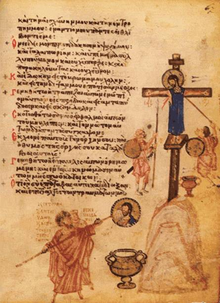
The Byzantine state, which had been dominated by Christianity and Greek since the 7th century , was culturally and politically completely dominated by its metropolis Constantinople , founded in 324/330 , where the imperial court was the most important client. In contrast to Western and Central Europe, Byzantine art continued the ancient legacy of the former Eastern Roman Empire until its end in the 15th century without interruption, albeit with waves of renewal. An important turning point for art was the Byzantine picture dispute, which suppressed the religious cult of pictures between 726 and 843 before Byzantine art experienced a new heyday from the 9th to the 11th centuries. Compared with the multitude of styles and epochs of Western book illumination, Byzantine illumination is characterized by extraordinary homogeneity, continuity and an insistence on the ancient imagery, despite this temporary break.
All of the renaissance of Western art, be it Carolingian, Ottonian or early modern times, owe essential impulses to Byzantine art. Illumination played an essential role as a mediator, because only the book medium made its way directly to the West and could be copied there in the scriptoria. Byzantine artists were also partly active in the occidental studios. With the Exarchate of Ravenna and the Catepanate of Italy , Byzantium had important bridgeheads in the west until the 8th century. Later, the Republic of Venice was an important ally and trading partner through whom cultural exchange took place. Only with the defeat of the Byzantine Empire by the fourth crusade , in which against the protest of Pope Innocent III. Constantinople was captured and looted in 1204 and through which Byzantine art experienced a significant slump, the contacts largely broke off.
While the Slavs in the north and east could be Christianized in the 9th and 10th centuries and brought under the influence of Constantinople, attacks in the east and south first by the Persians , then the Arabs, as well as the Bulgarians , Mongols and Turks presented a constant threat Centuries of struggle for existence, the Byzantine Empire finally collapsed in 1453 with the fall of Constantinople . Many Byzantine scholars subsequently fled to Italy, bringing with them numerous ancient and Byzantine books. In Constantinople, a large part of the works of art fell victim to the looting and destruction of the conquerors.
Constantinople and the Byzantine Empire

In terms of style, ancient and Byzantine art cannot be clearly separated from one another. Usually the epoch of Justinian I (527-565) is regarded as the beginning and first high point of Byzantine art, since Constantinople now became the determining reservoir for all artistic forces of the entire empire, who had their most important patron in the emperor. The epoch known as the Justinian Renaissance was characterized by a productive renovatio of the classical language of forms, which merged the various currents of post-ancient art into one unit. The aesthetic character of Justinian art remained exemplary for Byzantine art for centuries.
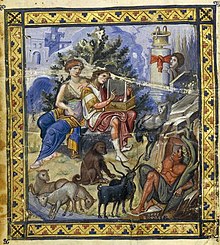
In the time of the Byzantine picture dispute in the 8th and 9th centuries, liturgical book illumination was limited to crosses and ornaments, only a few religious illustrated manuscripts have survived. The illustration of secular subjects, on the other hand, was apparently not affected by iconoclasm. Nevertheless, the tradition tore so far that illustrations from church books after 843 with stiff figures, mask-like faces and a linear style of folds initially could not match the earlier quality.
After the picture dispute, the illustrators reverted to the collection of illustrated books from the late antique-early Christian period. Illumination gained new impetus from Basil I of the Macedonian dynasty , after which this artistic epoch was given the name “ Macedonian Renaissance ”. The 10th century produced masterpieces whose characteristics were landscapes with atmosphere, expressive, painterly designed faces and a classic canon of figures. The individually designed illustrations succeeded in creating their own creations in the spirit of antiquity, without slavishly copying traditional templates.
Around the year 1000, Byzantine illumination left the naturalistic and elegant style of the Macedonian Renaissance adopted from antiquity. The now prevailing mode is characterized by sharply contoured faces and robes, mannered movements, inorganic, overlong shapes, unrealistic landscapes and architectures as well as an extensive renunciation of physicality and spatial depth.
Areas of influence of Byzantine art
The Byzantine tradition is embodied to this day mainly by the Orthodox and ancient Near Eastern churches , which are based directly on the Byzantine rite .
Middle East
The pre-Islamic Syrian illumination of the 6th century was initially characterized by the stylistic continuity of the ancient tradition. The canon tables were decisive for the subsequent illumination , until figurative illustrations were used again in the 11th century, which were mainly influenced by Byzantium, but also by Islamic book art and the art of the Crusader states . The development of a uniform Syrian style prevented the division of the Christian minorities into Jacobites , Maronites , Melchites and Nestorians .

The early Armenian illumination is also an oriental variant of Byzantine art, which was influenced by Syrian but also by Coptic and occasionally by Western painting. Tradition begins to a greater extent in the 10th century. In the 11th century, schools of illumination emerged in Turuberan , Sebaste and possibly a court school in Kars . Few illuminated manuscripts have survived from the 12th century whose very linear style shows a dwindling influence of Byzantium. The manuscripts of the 13th century show very strong differences and the most varied of influences. In the 13th and 14th centuries, this climax was followed by a breakdown into a wide variety of styles.
In Georgia , which was nominally under Byzantine suzerainty, Byzantine influence was particularly dominant. The first illuminated manuscripts date from the 9th and 10th centuries. With the decline of Byzantium, Georgian book illumination also sank to a modest, provincial level.
Balkans and Old Russia

Traditional Serbian book illumination began towards the end of the 12th century and mixed the cultural influences of Byzantium and the Latin West. In the 14th century the art of Serbia turned to the whole of Byzantium and reached its peak at the same time.
The Bulgarian Illumination experienced under the Tsar Ivan Alexander in the 14th century a sudden bloom in a very strong byzantinisierenden style after previously only less demanding and mostly purely ornamental designed illuminations had been created. In the 15th century, figurative painting disappears again from Bulgarian book illumination and the illuminations are again limited to artistic ornamentation until the 16th century.
Romanian illuminations only appear around 1400 and are entirely part of late Byzantine art. The masterpieces of Romanian book art were created under Stefan the Great around 1500.
In Old Russia , the reception of Byzantine book illumination gave rise to its own style. Novgorod and Kiev were important centers of art for early Russian illumination . Approaches to a reception of western illumination could not develop due to Mongol invasions and annexations by Lithuania in the 13th and 14th centuries. Around 1200 production centers appeared in Rostov , Yaroslavl , Suzdal and elsewhere.
Copts
Egyptian tradition evolved into Nubia and Ethiopia , the Christian art of the Copts . Influenced by Byzantine painting, it remained largely isolated and sealed off due to its marginal or island position, especially after the invasion of the Arabs in 641.
In style continuity with isolated secular papyrus fragments from the 5th century, the first Christian book illumination has come down to us from the 7th century. Upper Egyptian Sahidic manuscripts of the 8th to 10th centuries have strict frontality, pure flatness, linear folds and faces with large, staring eyes in common. A common iconographic motif in these manuscripts is the Maria lactans . This is completely lacking in the later Bohairian manuscripts from Lower Egypt . This illumination flourished when it was influenced by Byzantine art from the late 12th to the end of the 13th century.
Islamic book illumination
Lore
In the Islamic world, manuscripts have been dismantled very often for centuries and the individual sheets are then combined with paintings of completely different origins to form new albums, so-called muraqqas . This habit results in a very fragmentary tradition and a comparatively poor research situation in Islamic book illumination. The oldest text illustration that can be dated is an astronomical treatise from the year 1009; a large number of Islamic book illuminations have only come down to us from the 13th century. The fact that, in addition to purely calligraphic and ornamental text markings, there previously existed a painting tradition that was simply not tangible because of the great losses, was previously considered unlikely, but now appears possible due to more recent fragments. Around the middle of the 16th century, the production of illuminated manuscripts declined and single-sheet drawings and paintings took their place.
Design principles and functions
Islamic illumination is determined by two opposing basic positions: on the one hand, Islam - like Christianity and Judaism - is a book religion; on the other hand, a ban on images prohibits figurative representations, even if the Koran does not formulate this ban directly. Religious works are therefore limited to magnificent ornamentation and calligraphy, but Islamic book art is also particularly characterized by abstract geometric patterns. In particular, the complex arabesques developed from Greek and Roman acanthus tendrils developed into differentiated and varied decorative patterns by the Arab illuminators.
Although the ban on pictures is not limited to the religious sphere according to a strictly orthodox view, extremely imaginative figural painting can be found in the secular area. Islamic book illumination did not have a linear perspective , only the perspective of meaning . It was not until the 17th century that European art had an increasing influence on Persian painting that the central perspective and contrasts using light and shadow penetrated . Modeling by means of color gradations was also little used stylistic device. Instead, the painters preferred pure colors and indicated drapery, for example, by lines. The symbolic meaning of individual colors could differ considerably in different regions and at different times and even assume opposing connotations.
Genera of illuminated manuscripts

It is possible that figurative illustration found its way into Islamic book art through scientific works, which were often linked to Hellenistic-Byzantine traditions. The oldest illustrated book in the Islamic world, the Kitab Suwar al-Kawakib al-Thabita from 1009, remained the only such work for a long time, but the number of illustrated factual texts clearly exceeded all other genres in later centuries. It is noticeable that the illustrations of factual texts had less of a practical use than decorative purposes.
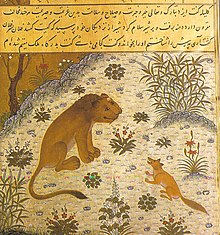
The two most illustrated poems were the fable book Kalīla wa Dimna and the Makamen of Hariri . The oldest illustrated manuscript of Kalīla wa Dimna was illuminated around 1200-1220, but the iconology of the fables could go back to pre-Islamic times and point to Indian traditions. The 50,000-verse Persian epic Shahname has been particularly splendidly illustrated since the early 14th century .
Materials and technology
The writing material used in Islamic book illumination was almost exclusively paper from East Asia , which had reached the Arabian Peninsula in the 8th century and had established itself in the middle of the 10th century. The preference for different types of paper varied from wafer-thin paper made from silk fibers to thick cardboard. Specialized papermakers tinted the sheets, cut them to size, and marbled or sprinkled them with gold as needed.
Most of the opaque watercolors were mineral in nature and were made from lapis lazuli , malachite, and similar stones that were powdered and mixed with gold or silver. Organic colorants were also used. Finally, the painting was given golden highlights and hardened by polishing with agate or crystal .
The brushes often consisted of bird feathers reinforced with hair from young goats or squirrels.
Artist
In the Arab world, calligraphy, which became the dominant form of Islamic art, was more highly regarded than illustration. The most highly paid illuminators were in the service of a great gentleman and were respected members of the court. Several princes and sultans successfully practiced book illumination themselves. Other illuminators were high officials at the same time, but slaves could also rise to become respected masters in Islamic illumination.
In addition to the painters at the courts, there were municipal commercial studios whose artists were organized in guilds and who produced countless manuscripts of a modest level for merchants or brotherhoods. We are best informed about the background of Islamic illumination in the area of Persian art of the 15th and 16th centuries.
Style history and regional characteristics
Arabic book illumination
The Arab world expanded since the 7th century during the Islamic expansion in the west to Spain and to the east through Persia addition to India from. In the Arab world, Syrian Damascus , the seat of government under the Umayyads , and under the Abbasids Baghdad in what is now Iraq, were the political and cultural centers. Miniature art flourished under the Mamluks on the Arabian Peninsula and in Egypt until it lost its importance at the end of the 14th century.
The early Islamic book illustration was still in the late Antique-Hellenistic and Byzantine tradition, but soon broke away from it and developed its own style that emphasized the abstract ornament and surface decoration.
Moorish book illumination

The Iberian Peninsula was shaped by Islam until the success of the Christian Reconquista in the middle of the 13th century , the Emirate of Granada remained under Muslim control until 1492. Since the end of the 15th century, the art of the Moors was restricted to North Africa . Less because of the Christian conquest than because of the religious rigorism of Malekite ulema , only one illustrated Moorish manuscript has survived in the Vatican library. It is a manuscript with 14 miniatures of the love story Bayâd wa Riyâd from the 12th or 13th century. The style of the pictures is two-dimensional and shows similarities to frescoes of Norman-Sicilian art. Christian book illuminations in Spain prove the existence of a Moorish painting school through recognizable influences of the art of the Mudéjares, despite the poor tradition .
Manuscripts with a pronounced calligraphic style, on the other hand, are numerous: In the 10th century, the Maghreb developed its own font, the Maghrebi Duktus .
Persian book illumination

After the conquest of Baghdad by the Mongols in 1258, the spiritual center of the Islamic world shifted to Persia, especially to Tabriz , the seat of the Mongolian Ilkhan . Here, based on the Sassanid tradition, from around 1300 a Persian miniature art developed, which gradually broke away from the Arab heritage under the impression of the Buddhist scrolls brought with them by the Mongols from India and China. A new realism, depicting the reality of nature, developed, which introduced landscape painting as a new genre in Islamic art .
After the end of the Ilkhan and a new Mongol invasion , initially accompanied by violence and cultural vandalism , the new ruling dynasty of the Timurids , which had again converted to Islam, unfolded new splendor in the current residence of Herat . Illumination now illustrated particularly historical works with the greatest decorative elegance in a controlled but poetic style. Persian book art reached its first high point in the first half of the 15th century, when it was refined by the art of the Ming dynasty as a result of close trade relations with China .
The style of Persian miniature painting changed again after the conquest by Qara Qoyunlu - Turkmen in 1452 and now took on lively, downright ecstatic forms of expression. East Asian dragons and animals found their way into the iconography, the surfaces are designed with unreal effects.
Also under the dynasty of the Safavids , which from 1501 Shi'ism instead of Sunnism established as the state religion, book painting witnessed new heights. This exerted a strong influence on Indian Mughal painting until it experienced a slow but steady decline in the 17th century. The most famous Persian miniature painter of the late Timurid and early Safavid dynasties was Behzād , who directed large studios on behalf of the Sultan Hussein Bāyqarā in Herat and the Shah Ismail I in Tabriz and was a master at the representation of genre scenes. In the late Safavid period in the 16th and 17th centuries, the Isfahan school flourished , the greatest representative of which is Reza Abbasi .
Indian Mughal painting

At the beginning of the 16th century, the Mongols, called Mughals in the Arabized form , established an extensive empire in India , where previously there had only been isolated Islamic rule. The courtly painting school of the Mughals came into being under Humayun , who, on his return from Persian exile in 1555, introduced two Persian painters, Mir Sayyid Ali and Chwadscha Abd as-Samad , to the Indian Mughal court for the first time . The dominant cultural influence of the Persian courts merged with Indian, especially Hindu, art to form an independent Mughal style from around the middle of the 16th century . At Akbar's cosmopolitan court , which was even flocked by Europeans, almost exclusively Hindus worked in the painting school run by Persian artists.
The themes are predominantly secular, with particularly poetic and historical works being illustrated. Common motifs are depictions of the courtyard, hunting scenes, images of animals and plants. The miniatures of the "Parrot Book" (Tutinama) enjoyed a high status in the art of the Akbar period . As a new theme, portraits of leading figures of the state, including the rulers themselves, are entering Indian art . Akbar had not only his own biography, but also the chronicles of Babur and Timur richly illustrated. Well-known artists of the era were Daswanth , Basawan and his son Manohar .
The high-format miniatures of the Mughal style are characterized, among other things, by the use of the cavalier's perspective , predominantly point-symmetrical compositions and colored areas loosened up by internal drawings. One of the earliest datable works is a Hamzanama manuscript written between 1558 and 1573 during Akbar's reign , which originally contained around 1400 miniatures. While some of the approximately 150 surviving illustrations with flat, rather static-looking images integrated into the lines of text follow the Persian painting tradition, most of them show clear Indian influences: the image composition is far more flexible, the arrangement of the figures more dynamic, image and text are usually placed side by side. Unlike earlier Jain and Hindu manuscripts, each folio has an illustration.
Mughal art received new impulses during the reign of Jahangir from 1605 to 1627. The miniatures of this time placed little emphasis on mass representations, as was common under Akbar, and instead are characterized by the most naturalistic representations possible of people, animals, plants and objects. Typical are detailed portraits collected in albums and Indian landscapes, which replaced the previously common stylized Persian picture backgrounds.
The coloring, on the other hand, with bright colors and gold, remained committed to Persian art. While several artists often worked on one painting in Akbar's painting school, most of the paintings from the Jahangir period were individual works. As a result, fewer works of art were created, but they achieved a higher artistic level. Overall, the era of Jahangir is considered the heyday of Mughal painting. Many names of famous artists have survived from that time, including Abu al-Hasan , Mansur , Bichitr and Bishandas . Jahangir ordered his court painters to study European copperplate engravings that had come to Akbar's court from Portuguese Jesuits since 1580 and to copy them in style. As a result, miniature portraits based on European models found their way into Mughal art, as did the central perspective and the halo of Christian iconography that adorned the head of the ruler.
Under Shah Jahan and Aurangzeb , book illumination lost its importance in the course of the 17th century and finally died out towards the end of the 18th century. Many artists left the court, but elsewhere contributed to the flourishing of regional schools in the 18th century, for example in Rajasthan , where the Rajput style had developed parallel to the Mughal style as early as the 16th century.
Ottoman book illumination

Under the cultural influence of Persian art, that of the Ottoman Empire , which had expanded rapidly since the 14th century, developed into an independent and unmistakable style. The Ottoman residence was initially Bursa , then Adrianople until the capital was moved to Constantinople, conquered in 1453, which was later renamed Istanbul . The heyday of Ottoman miniature painting was the 16th century, when the majority of the illustrated manuscripts were created.
The promotion of secular court art was the traditional privilege of the sultans. That is why depictions from Ottoman history and illustrated family trees of the Ottoman dynasties dominated, whose genealogies often began with Adam and Eve and included famous, legendary and historical figures. Particularly important political, warlike or official events in contemporary history were documented, and everyday life at court was a frequent subject of the illustrations. In all of these illustrations, the sultan as the dominant figure and his court were the focus of artistic interest. Ottoman miniature painting was an important medium for the ruling representation of the Padishah .

The first major illustrated chronicle of this kind was under I. Süleyman mid-16th century resulting Süleymanname . Famous painters Surname -called hard books were late 16th century Nakkaş Osman and an outstanding painter of Levni at the beginning of the 18th century. With the aim of glorifying the sultan, portrait painting also developed at court , which, in addition to the portrait of the ruler, was limited to the occasional depiction of high dignitaries. As early as 1500 Ottoman sultans invited European artists, such as the Renaissance painter Gentile Bellini , to their court, so that elements of Western art found their way into Ottoman portrait art. Landscape painting also began to develop through the background of history painting and portraiture. In the panoramas, the painters often depicted fortifications and cityscapes with documentary accuracy, which were based on the long tradition of detailed cartography.
The Turkish painting was generally characterized by greater objectivity than the Persian and also the Arab. It was characterized by a meticulous wealth of details, but remained formulaic and unrealistic. Insights into European art were limited to a few elements such as the bust in profile or three-quarter profile, while proportions, perspective or modeling with light and shadow were ignored and the representation remained two-dimensional, two-dimensional and incorporeal. It was not until the 17th century that the beginnings of perspective constructions appeared in architectural depictions. The Ottoman paintings gained their expressiveness through the intense contrasts of the often unreal colors and their wealth of detail.
Book printing did not come to the Ottoman Empire until the beginning of the 18th century and never really caught on, so that manuscripts remained the most important written medium until the 19th century. The miniature therefore remained the dominant art genre until the 18th century, before a reorientation took place under the influence of Western painting.
Jewish illumination
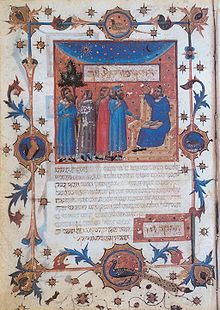
The liturgical Jewish Bibles used in the synagogue were basically in the form of scrolls and were always unadorned. Another special feature was that the parchment for Jewish books had to come from kosher animals. The illustrated religious books were intended for private use, primarily the Hebrew Bible with the Torah , the Pentateuch , the Prophets and the Ketuvim . Other Jewish texts that were frequently illustrated were the Haggada , the Ketubba marriage contract, and the writings of Maimonides and Rashi .
Even if Jewish book illuminations are only passed down from the 9th to 10th centuries in the oriental cultural area, the art of Jewish illustration probably goes back to antiquity. The leaf ornamentation of the oldest surviving Jewish book illumination did not differ from the illustrated Koran manuscripts of the 9th century from Persia, Syria and Egypt. In the 14th century, Jewish book illumination in the Orient experienced its decline - only in Yemen did it still flourish in the 15th and 16th centuries. Here the illustration mostly took the form of full-page ornamental carpet pages, with micrographs in geometric patterns.
In Europe, Jewish illumination can only be proven in the 13th century. The book art of the Sephardi in Spain and the Jews in Provence was strongly influenced by oriental decoration systems and reached its peak in the 14th century. Characteristic were full-page illustrations and the display of the cult devices of the monastery tent in gold color. Typical of the few surviving Jewish Bibles from the Iberian Peninsula is the combination of European Gothic with Muslim ornamentation. This applies, for example, to the particularly magnificent Catalan Farchi Bible (1366–1382) by Elisha ben Abraham Crescas. With the expulsion of Jews from France in 1394 and 1492 from Spain , where many Jewish communities had already been smashed in 1391, and then from Portugal, this cultural prosperity in these countries ended abruptly.
German Jewish book illumination was mainly represented along the Rhine, with most of the manuscripts coming from the southern German Upper Rhine region. It differed greatly from oriental and Spanish book art: instead of the carpet pages, micrographics and pen drawings dominated, the cult devices of the monastery tent, which were rarely missing in any Spanish Bible, were rarely illustrated.
The center of Jewish book illumination in Italy was at the beginning, in the 13th century, in Rome and central Italy, but in the second half of the 14th century it shifted to Bologna . In the 15th century Florence became the most important center, but there were also other central and northern Italian schools in Mantua , Ferrara , Venice and Padua . In southern Italy, Hebrew book illumination flourished, especially in Naples . Jewish book art reached its zenith in the Italian Renaissance .
Reasons for the generally poor tradition of Jewish book illumination are, in addition to the expulsion of Jews from various countries, anti-Semitic iconoclasms and the hostile environment in Islamic Arabia and during the iconoclasm in Byzantium, from which Judaism was also difficult to escape. Like the rest of European illumination, Jewish illumination also experienced its decline as a result of the printing press. In 1475 the first dated Hebrew book was printed in Reggio , there were still Jewish printing works in Spain and Portugal in the 15th century, in Prague at the latest in 1526 and in Constantinople in 1527 .
Buddhist illumination
In India and Tibet, Buddhist sacred books were sparsely illustrated on palm paper and kept between book covers.
In China , the ink drawing dominated the text illustration, which mostly appeared as a (hanging) scroll and thus does not represent book illumination in the narrower sense. The illustrations were mostly close to the autonomous picture and illustrated or structured the text less than, for example, in European book illumination. Because of the technical proximity of calligraphy and ink drawing, the boundary between the two arts was largely eliminated. In addition, the woodcut had been known since the 9th century.
The technique of the Japanese art of illustration hardly differed from the Chinese. Ink drawings dominated.
Old American book illumination
Aztecs

The pre-Columbian illuminated manuscripts of the Aztecs illustrated mainly historical and mythical events using pictograms and ideograms , but also calendars and information about tributes and origins . It was only after the Spanish colonization that an alphabetized form of the Aztec language - the Nahuatl - appeared alongside pictorial writing. The codices serve today as the best primary sources for the culture and life of the Aztecs. They were painted either on specially prepared animal skins (for example deerskin), on the bark of the fig tree or on canvases made of cotton cloth. Natural colors were used for the lettering and painting. The pages, which were painted on both sides, were folded into books like a leporello after completion .

Immediately after the arrival of the Spaniards, a large part of the pre-Columbian codices were destroyed by them and only a small part ended up as collectibles in European museums and libraries. Only after the complete subjugation and Christianization of the Aztecs did the interest of the European conquerors in the Aztec culture slowly develop and so the tradition of the codex painters could be continued in the colonial era. A large part of the Aztec codices known today as well as copies or transcripts of already destroyed pre-Columbian codices originate from this period.
Maya
According to Spanish sources, the Maya had scientific books, calendars and lists of their festivals and temple ceremonies in large numbers, most of which had been destroyed as pagan objects by the conquistadors shortly after the Spanish conquest of Mexico . Only four manuscripts have survived : The Madrid Codex or Codex Tro-Cortesianus , the Codex Dresdensis , the Codex Peresianus and the Codex Grolier .
Modern reception
Thanks to the possibilities of photomechanical reproduction , many book illuminations are now generally accessible and have a significant share in the public image of the Middle Ages. Excerpts from medieval book illustrations are preferred motifs in specialist and popular science books as well as historical novels.
For scientific research as well as for bibliophiles, the particularly complexly produced full facsimiles are decisive, often costing five-digit euro amounts. In an attempt to come as close as possible to the original, any worm-eating holes are cut out in the precious specimens and real gold leaf is even applied. There are also simpler and more cost-effective facsimiles that can be reduced to a standard book format. Since the 1980s, black-and-white facsimiles have only been used for manuscripts that are not of interest to art history, but to philological studies.
Since the 1990s, the digital reproduction of medieval manuscripts has found its way into art history .
literature
- K. Beer brewer, Ø. Hjort, Otto Mazal , D. Thoss, G. Dogaer, J. Backhouse, G. Dalli Regoli, H. Künzl: Illumination . In: Lexicon of the Middle Ages (LexMA). Volume 2, Artemis & Winkler, Munich / Zurich 1983, ISBN 3-7608-8902-6 , Sp. 837-893.
- Albert Boeckler, Paul Buberl, Hans Wegener: Illumination , in: Reallexikon zur Deutschen Kunstgeschichte , Vol. 2, 1950, Col. 1420–1524
- Jacques Dalarun (Ed.): Le Moyen Âge en lumière. Manuscrits enluminés des bibliothèques de France . Fayard impr., Paris 2002, ISBN 2-213-61397-4 (German: The luminous Middle Ages (from the French by Birgit Lamerz-Beckschäfer). Primus, Darmstadt 2011, ISBN 978-3-89678-748-4 ; also licensed edition : Wissenschaftliche Buchgesellschaft , Darmstadt 2006, ISBN 978-3-534-19004-1 ).
- Johann Konrad Eberlein: miniature and work. The medium of illumination. Suhrkamp Verlag, Frankfurt am Main 1995, ISBN 3-518-58201-1 , (also: Kassel, Gesamtthochsch., Habil.-Schr., 1992).
- Ernst Günther Grimme : The History of Occidental Illumination. 3. Edition. DuMont, Cologne 1988, ISBN 3-7701-1076-5 .
- Christine Jakobi-Mirwald: Illumination. Your Terminology in Art History. 3rd revised and expanded edition with the assistance of Martin Roland. Reimer, Berlin 2008. ISBN 978-3-496-01375-4 , ( art studies ); 4th, revised edition 2014, ISBN 978-3-496-01499-7 .
- Christine Jakobi-Mirwald: The medieval book. Function and equipment. Reclam, Stuttgart 2004, ISBN 978-3-15-018315-1 , ( Reclam's Universal Library 18315), (especially chapter history of European book painting, pp. 222-278).
- Margit Krenn, Christoph Winterer : With a brush and quill pen. History of medieval illumination. Scientific Book Society, Darmstadt 2009. ISBN 978-3-534-22804-1 .
- Otto Pächt : Illumination of the Middle Ages. An introduction . Edited by Dagmar Thoss. 5th edition. Prestel, Munich 2004, ISBN 978-3-7913-2455-5 .
- Heinz Roosen-Runge: Coloring and technique of early medieval book illumination. Studies on the treatises "Mappae Clavicula" and "Heraclius". 2 volumes, Munich 1967 (= art studies , 38).
- Heinz Roosen-Runge: Color, colorant of occidental medieval book painting , in: Reallexikon zur Deutschen Kunstgeschichte , Vol. 6, 1974, Col. 1463–1492
- Heinz Roosen-Runge: Illumination . In: Hermann Kühn among others: Colorants. Book illumination. Panel and canvas painting. (= Reclam's Handbook of Artistic Techniques. Volume 1). 2nd Edition. Reclam, Stuttgart 1997, ISBN 3-15-030015-0 , pp. 25-124.
- Karl Klaus Walther (Ed.): Lexicon of book art and bibliophilia. Approved license issue. Nikol, Hamburg 2006, ISBN 3-937872-27-2 .
- Ingo F. Walther, Norbert Wolf : Masterpieces of book illumination. The most beautiful illuminated manuscripts in the world from 400 to 1600. Taschen, 2nd edition, Cologne 2011, ISBN 978-3-8228-4747-3 .
- Christoph Winterer, Margit Krenn: With a brush and quill pen. History of medieval illumination. Primus, Darmstadt 2009, ISBN 978-3-89678-648-7 .
- Norbert Wolf : Understanding book illumination. Primus, Darmstadt 2014, ISBN 978-3-86312-375-8 .
- Paths to the illuminated book. Production conditions for book illumination in the Middle Ages and early modern times. Edited by Christine Beier and Evelyn Theresia Kubina, Vienna 2014, ISBN 978-3-205-79491-2 , Online: https://e-book.fwf.ac.at/detail_object/o:521
Web links
- Manuscripta Mediaevalia
- Heidelberg University: Project Late Medieval Illuminated Manuscripts from the Bibliotheca Palatina ( Memento from March 29, 2010 in the Internet Archive )
- University of Heidelberg: Glossary on Illumination ( Memento from August 19, 2010 in the Internet Archive )
- British Library, Catalog of Illuminated Manuscripts
- Initiale - Catalog de manuscrits enluminés
- Brief inventory of illuminated manuscripts in Herzogenburg Abbey
- Brief inventory of the illuminated manuscripts in Stams Abbey
Individual references and signatures of the manuscripts mentioned
- ↑ a b LexMA, Col. 837.
- ↑ For information on the colors and binders used in medieval illumination, see Roosen-Runge, pp. 75–103.
- ↑ Vergilius Augusteus , Rome, Biblioteca Vaticana , Vat. Lat. 3256 and Berlin, State Library , lat. Fol. 416.
- ↑ Florence, Laurenziana , Plut. LXV. 1.
- ↑ Jakobi-Mirwald, p. 167.
- ↑ Chantilly, Musée Condé MS. 66.
- ↑ a b c Gereon Becht-Jördens: Litterae illuminatae. On the history of a literary form type in Fulda , in: Gangolf Schrimpf (Hrsg.): Fulda monastery in the world of the Carolingians and Ottonians (Fuldaer Studien 7). Josef Knecht, Frankfurt am Main 1996, pp. 325–364. ISBN 3-7820-0707-7
- ↑ Milan, Biblioteca Trivulziana, Cod. 470.
- ↑ Chantilly, Musée Condé , Ms. 65.
- ^ Theo Kölzer, Marlis Stähli (ed.): Petrus de Ebulo. Liber ad honorem Augusti sive de rebus Siculis. Codex 120 II of the Burgerbibliothek Bern. A pictorial chronicle of the Staufer era , text revision and translation by Gereon Becht-Jördens. Jan Thorbecke, Sigmaringen 1994.
- ↑ The Hague, Book Museum, Ms 10 B23, 2r.
- ↑ Kunibert Bering, Art of the Early Middle Ages , Stuttgart 2002, p. 151.
- ^ Stockholm, Kungliga Biblioteket , MS A. 135, folio 11
- ↑ Vera Trost: Gold and Silver Inks Technological Investigations on Occidental Chrysography and Argyrography from Late Antiquity to the High Middle Ages. (Phil. Diss. Würzburg 1983), Wiesbaden Harrassowitz, 1991, ISBN 3-447-02902-1 .
- ^ Heidelberg, Heidelberg University Library , Cpg 339 .
- ↑ So Ehrenfried Kluckert, Romanesque painting, in: Die Kunst der Romanik , ed. v. Rolf Toman, Cologne, 1996, p. 383.
- ^ Albert Boeckler and Alfred Schmid: Die Buchmalerei . In: Georg Ley (Ed.): Handbuch der Bibliothekswissenschaft . Harrassowitz, Wiesbaden 1952. p. 252.
- ↑ Rome, Vaticana, Vat. Lat. 3867.
- ↑ Quedlinburger Itala , Berlin, State Library, Theol. lat. fol. 485.
- ^ Leiden, University Library , Bibl. Voss. lat. qu. 79 and London, British Library , Harley 647.
- ↑ Rome, Biblioteca Vaticana, Vat. Lat. 3868
- ↑ So the Vergilius Vaticanus , Rome, Biblioteca Vaticana, cod. lat. 3225 and Vergilius Romanus , Rome, Biblioteca Vaticana, Vat. lat. 3867.
- ↑ Chronograph from 354 .
- ^ Ashburnham-Pentateuch , Paris, Bibliothèque nationale , nouv. acq. lat. 2334.
- ^ London, British Library, Ms. Cotton Otho B VI
- ↑ Milan, Biblioteca Ambrosiana , Cod. F 205 Inf.
- ^ Vienna, Austrian National Library , Cod. Med. gr. 1.
- ↑ Vienna, Austrian National Library, Cod. Theol. size 31.
- ^ Rossano, Diocesan Museum.
- ^ Paris, Bibliothèque nationale, Suppl. Gr. 1286.
- ↑ So u. a. Jakobi-Mirwald, p. 232.
- ↑ Rome, Biblioteca Vaticana, Reg. Lat. 316, 131v / 132r.
- ↑ Walther, Wolf, p. 33.
- ^ London, British Library, Add. 49598.
- ^ Rouen, Bibliothèque municipale, Ms. 369.
- ^ Madrid, Escorial, Ms. & II. 5
- ↑ Grimme, p. 108.
- ↑ Fulda, State Library, Ms. D 11.
- ^ New York, Pierpont Morgan Library , M. 834
- ^ Paris, Bibliothèque nationale, Ms. gr. 139, 1v.
- ^ Paris, Bibliothèque Nationale.
- ↑ Yerevan, Matendaran, Ms. 10675.
- ^ Saint Petersburg, Russian National Library .
- ^ British Library Add. MS 59874
- ↑ a b c Robert Irwin: Islamische Kunst , DuMont, Cologne 1998, p. 181.
- ↑ Lexicon of Book Art and Bibliophilia, p. 114.
- ^ A b Robert Irwin: Islamische Kunst , DuMont, Cologne 1998, p. 191.
- ↑ Istanbul, University Library, Ms. A. 6753.
- ^ A b Robert Irwin: Islamische Kunst , DuMont, Cologne 1998, p. 196.
- ↑ Istanbul, Topkapu Saray Museum .
- ^ Robert Irwin: Islamische Kunst , DuMont, Cologne 1998, p. 184.
- ^ Vienna, Austrian National Library, Ms. AF 9.
- ↑ Rome, Vaticana, Ms. Ar. 368.
- ↑ a b Burchard Brentjes : Die Kunst der Mauren , DuMont, Cologne 1992, p. 237.
- ^ Burchard Brentjes : Die Kunst der Mauren , DuMont, Cologne 1992, p. 235.
- ^ London, British Library
- ↑ Los Angeles County Museum of Art.
- ↑ Gascoigne, The Mughals. Splendor and greatness of Mohammedan princes in India . Prisma Verlag, Gütersloh 1987, p. 99 f.
- ↑ Joachim K. Bautze: The transportable painting from the 13th century. In: India. Culture, history, politics, economy, environment. A manual. Verlag CH Beck, Munich 1995, p. 265 f.
- ↑ Gascoigne, The Mughals. Splendor and greatness of Mohammedan princes in India . Prisma Verlag, Gütersloh 1987, p. 146 ff.
- ↑ a b Istanbul, Topkapi Museum.
- ↑ a b c d e f Ottoman miniature painting ( Memento of the original from May 24, 2008 in the Internet Archive ) Info: The archive link has been inserted automatically and has not yet been checked. Please check the original and archive link according to the instructions and then remove this notice. on the website of Karlsruher Türkenbeute of the Badisches Landesmuseum Karlsruhe.
- ↑ Copenhagen, Kongelige Bibliotek, Cod. Heb. 37.
- ↑ Miriam Magall: A short history of Jewish art. Cologne, DuMont 1984. p. 219.
- ^ Letchworth, Collection of Rabbi DS Sassoon, Ms. 368.
- ↑ Miriam Magall: A short history of Jewish art. Cologne, DuMont 1984. p. 259.
- ^ Madrid, Museo de America.
- ^ Dresden, Saxon State Library , Mscr. Dresden. R 310.
- ^ Paris, Bibliothèque nationale.


